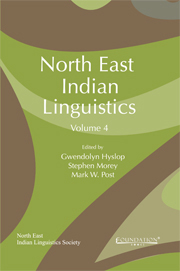Book contents
- Frontmatter
- Contents
- About the Contributors
- Foreword
- A Note from the Editors
- History, Contact and Evolution
- Bodo-Garo Grammar
- Orthography, Poetics and Text
- New Descriptions
- Classifiers
- Eastern Indo-Aryan Grammar
- Personal Pronouns in Madhav Kandali's Ramayana
- 16 Nominalization and the Nominalized Clause in Assamese
- 17 Copula Constructions in Assamese Sadri
- Austroasiatic
17 - Copula Constructions in Assamese Sadri
from Eastern Indo-Aryan Grammar
Published online by Cambridge University Press: 05 May 2013
- Frontmatter
- Contents
- About the Contributors
- Foreword
- A Note from the Editors
- History, Contact and Evolution
- Bodo-Garo Grammar
- Orthography, Poetics and Text
- New Descriptions
- Classifiers
- Eastern Indo-Aryan Grammar
- Personal Pronouns in Madhav Kandali's Ramayana
- 16 Nominalization and the Nominalized Clause in Assamese
- 17 Copula Constructions in Assamese Sadri
- Austroasiatic
Summary
Introduction
Copular constructions generally refer to clause structures where the subject is linked with nonverbal predicates like nominal, adjectival and locative. The purpose of such construction is to express notions like equation, attribution, location, existence and possession (Dryer 1985, Payne 1997). Traditional grammar defines the element that links the subject and the predicate in copular constructions as copula. Following Payne (1997: 111–121), the function of copula can be mainly divided into three: equative, attributive and locative.
Copula can be defined as a term used in grammatical description to refer to a linking verb ….whose main function is to relate other elements of the clause structure especially subject and complement. (Crystal 1980:93)
Masica (1991: 337) states: in Indo Aryan languages, “the function of copula is to identify, define and locate” the Subject NP. Copula in Indo Aryan languages can be overt and covert. It occurs in the final position in the clause structure like other lexical verbs. According to Masica (1991), verbs of this type perform two functions that of copular and existential. Normally copulas can be deleted whereas existential verbs cannot be deleted. Masica (1991: 337-338) further observes that existential verb can be covert in Assamese and Bangla.
Sadri, which is claimed to be an Indo Aryan language (Grierson 1903), also has different copular elements with similar functions, that of equative, attributive and locative. The copula in the present tense can be either obvert or covert. The construction where the copular element remains covert is considered as no copular construction.
- Type
- Chapter
- Information
- North East Indian Linguistics , pp. 353 - 370Publisher: Foundation BooksPrint publication year: 2012



